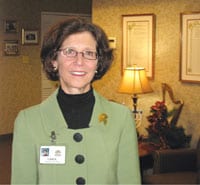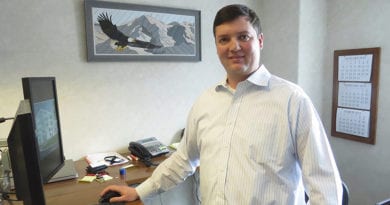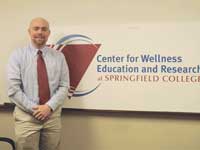Breaking the Mold – Carol Katz Reflects on 23 Years at Loomis Communities
Carol Katz believes that those who work in elder care face a harsh reality.
“And that reality is, nobody wants to grow old,” she said. “Nobody wants to be frail and have somebody else take care of them.”
That’s why Katz has devoted much of her career with Loomis Communities to making sure that residents of its four facilities — and their families — have as much say in their care as possible.
“Everyone is going to grow old,” she said. “But you can be the master of your own destiny and choose to move somewhere that you’re going to have the highest quality of life, and know that, if you need care, you’re going to get it in a very high-quality way.”
From her arrival at Loomis in 1989 to her retirement this month, Katz has become increasingly committed to a concept called ‘patient-centered’ or ‘resident-centered’ care (more on that later), and has watched with satisfaction as much of healthcare in general has recognized the value of that innovation and followed suit.
“That’s a huge change in the industry that’s kind of turned the whole medical model upside-down,” she said, citing an early advocate of patient-centered care, Dr. William Thomas, who compared the shift with how childbirth has evolved over the decades.
“He talked about the way childbirth used to be handled; the doctor was in charge, the woman’s legs were in stirrups, and the doctor used forceps to deliver the baby. Over the course of a generation, women rebelled against
this; they said, ‘this isn’t the way I want to have a baby.’
He compared that to traditional elder care, she continued. “The residents of tomorrow are not going to accept the old, institutional nursing-home setting. There are people in need of nursing home care, and we need to provide it in a way that puts the person being served at the center. It’s not for the staff to decide what you need.”
For this issue, we sit down with Katz to discuss the past two decades and how Loom is has expanded, faced some daunting new challenges in its field, and emerged as a trailblazer in its resident centered focus and continuity of care.
Almost three years ago, BusinessWest magazine, HCN’s parent publication, recognized Katz as one of its Difference Makers — and she doesn’t plan to stop making a difference, even in retirement.
Uncommon Model
A Northampton native, Katz attended college in Wisconsin and launched a career there in nursing-home administration.
When she returned to Massachusetts in the 1980s, she took a post at Heritage Hall in Agawam until Loomis House in Holyoke came calling. Both its nonprofit status — she had previously worked only at for-profit companies and its model of care immediately intrigued her.
“When I came here in 1989, Loomis House was the first continuing-care retirement community in Western Mass. to have independent living, assisted living, and skilled nursing care under one umbrella, so people could move to other levels of care as their needs change” without transferring residences, she said.
“It wasn’t a new concept in the country, but it was new in Massachusetts,” she added. “There weren’t many places where you could receive excellent quality of care in any setting.”
Katz was promoted to CEO of the nonprofit organization a few years later, around the time Loomis Village in South Hadley was opening (the first of three phases, anyway). Since then, the Loomis Communities acquired Applewood in Amherst, another nonprofit, in 1999, and procured Reeds Landing in Springfield out of bankruptcy in 2009.
With four facilities, sometimes that continuum of care requires a move within the organization — Applewood,
for instance, offers only independent and assisted living, and residents sometimes transfer later on to Loomis House, which focuses on nursing care. But families are relieved, Katz said, that their loved ones don’t have to endure a total culture change when they move.
Loomis House, the company’s flagship, first opened its doors in 1911, on the site of what is now Sarawood Assisted Living in Holyoke. It moved to its current, larger location on Jarvis Avenue in 1981. And the three decades since have perhaps seen more changes in senior care, and healthcare in general, than the century before.
“First, there have been a lot of changes in regulations — nursing-home regulations, Medicare regulations and the negative is more and more scrutiny and the whole tangle that regulations bring,” Katz told HCN. “But I feel like some good has come of it, too; the regulations have really pushed resident rights and resident well-being. I feel like the organizations I’ve worked for have promoted that all along, but many, many healthcare organizations, and the industry as a whole, have really been forced to set the bar higher and strive for excellence and quality care and dignity.”
Specifically, she credited a shift at Loomis to the patient-centered model of care, which strives to create a more homelike (read: non-institutional) setting and includes residents and families, to an unprecedented degree, in decisions about their care and services. If that means switching staff schedules around to accommodate when a resident wants to take a shower — rather than sticking to a strict shower schedule for everyone — then so be it.
Loomis Communities became one of the first organizations of its kind to receive state grants to implement this way of providing care, and Loomis House was just the second nursing home in North America to receive personcentered care accreditation. Katz said giving residents and families more selfdetermination over their care — which has required much retraining of nurses brought up under the institutional model — has been a huge positive in the company’s bottom line, too.
“Turnover has plummeted, resident satisfaction is higher, staff satisfaction is higher, family satisfaction is higher,” she told HCN. “And it’s the right thing to do; residents should make as many decisions as they can by themselves, and if they can’t, then their family should make those decisions, not a staff member who doesn’t know them as well.”
Along the Continuum
Katz also credits one of Loomis’ other innovations — one that preceded her time there — with helping the company become a leader in what has become a rapidly changing healthcare industry in the 21st century. That, of course, is the contiunuum of care.
“On one hand, and in general, people are staying at home longer and tend to move into independent and even assisted living later in life,” she explained. “Also, when you look at some of the changes in healthcare — the rise of managed care and the beginnings of accountable-care organizations — it points out that the continuing-care retirement community we’ve been operating all these years is really like a mini-managed-care model.
“As people age,” she continued, “they don’t have to move to a more expensive setting. We can provide home-care services in their apartments; we can provide good nutrition and healthylifestyle programs that keep people healthier longer. We have always embodied the promise that managed-care organizations and those trying to save on healthcare costs have been embodying.”
Katz said senior-care administrators are facing a much different world in 2013, one in which healthcare in general is moving toward greater efficiencies. Part of that change has been hospitals’ tendency to discharge patients into residential rehab settings faster — part of a push to reduce costs by treating people in less “medicalized” settings, she noted — and senior-care facilities taking in, on average, sicker and frailer residents. “Our nurses are now trained at a much higher skill level than when I started.”
This shift makes an emphasis on patient-centered care even more important, she added.
“In order for a community not to become like an institution, residents really have to be at the center,” Katz said. “Person-centered care is really taking hold more and more throughout healthcare; you hear it even in hospital advertisements. At the same time as this emphasis on pushing down costs and reducing length of stay, all the medical components of taking care of people has to be done in a way that the patient is at the center and calling the shots.”
For this reason and others, her industry has become more challenging than it’s ever been, “but people have been saying that for along time,” she noted. “There have been challenges in every single era. Yes, it’s more challenging today. On the other hand, there’s better technology. In many ways, you’re replacing one challenge with another.”
And more changes are on their way. A planned expansion at Loomis Village will allow for piped in oxygen and other features, to care for residents with more medically complex issues. “It’s similar to what Baystate has done with its new ER — we’re expanding and providing for medical complexities in a more cost-effective setting.”
Katz said it’s critical that an organization like Loomis continue to stay ahead of the curve — in this case, recognizing that senior-living facilities are how caring for people that, 10 or 20 years ago, might be in the hospital.
“If you sit still, you fall behind,” she told HCN. “I think, for a small organization, we’ve always been good planners. We have a wonderful team; I think we’re all type-A people who recognize that we have to stay ahead of the challenges in the field.”
Moving On
Katz said she’s gratified by many aspects of her career: “being part of the development of person-centered care, watching the team managers on my staff grow and become empowered to make decisions, the fact that we’ve been able to be successful as a small nonprofit, and able to grow and thrive while many small organizations have closed or been acquired by larger organizations.”
Also, “we’re proud of having Applewood and Reeds Landing as part of our organization in a way that really keeps the individuality and culture of each community,” she added. “It’s not like a total culture change where we changed the name and stripped it of its assets. I’m proud that we’ve grown each one of these communities, and they have all contributed so positively to the whole, and made the others stronger too.”
As for her own plans, she isn’t one to slow down or disconnect. “I have a lot of interests; I’m involved in a lot of volunteerism, and I’d like to do more of that,” said Katz, who also serves on multiple nonprofit boards, and is interested in becoming certified as a SHINE (Serving the Health Insurance Needs of Elders) counselor, so she can work with seniors in navigating Medicare.
“I also have young grandchildren, and I want to spend time with them,” as well as with her recently retired husband, she added. “I’d like to travel, take some classes, nurture friendships I just haven’t had time to over the years. I feel like I’m going to stay active and involved in the community.”
She won’t be a stranger to Loomis, either, not with her father and motherin- law, both in their late 80s, living at one of its properties. And she’ll always be an advocate for elder care that puts residents first, and reducing the stigma some people associate with seniorliving facilities.
“Nobody feels guilt about rushing a family member to the hospital if that’s what they need,” she said. “But they often feel guilty about moving them to a nursing home, even if that may be best for their quality of life.” That’s Carol Katz, forever advocating, teaching — and learning.
“I feel privileged to have worked with older people,” she concluded. “I’ve learned a lot from them.”




